Removal of Positive Elevation Bias of Digital Elevation Models for Sea-Level Rise Planning
Abstract
1. Summary
2. Data Description
2.1. Elevation Survey Points
2.2. Digital Elevation Model Metadata
3. Methods
Supplementary Materials
Author Contributions
Funding
Acknowledgments
Conflicts of Interest
References
- Engelhart, S.E.; Horton, B.P.; Douglas, B.C.; Peltier, W.R.; Tornqvist, T.E. Spatial variability of late Holocene and 20th century sea-level rise along the Atlantic coast of the United States. Geology 2009, 37, 1115–1118. [Google Scholar] [CrossRef]
- Church, J.A.; White, N.J. Sea-level rise from the late 19th to the early 21st century. Surv. Geophys. 2011, 32, 585–602. [Google Scholar] [CrossRef]
- Church, J.A.; White, N.J. A 20th century acceleration in global sea-level rise. Geophys. Res. Lett. 2006, 33. [Google Scholar] [CrossRef]
- Cazenave, A.; Palanisamy, H.; Ablain, M. Contemporary sea level changes from satellite altimetry: What have we learned? What are the new challenges? Adv. Space Res. 2018, 62, 1639–1653. [Google Scholar] [CrossRef]
- Rahmstorf, S. A semi-empirical approach to projecting future sea-level rise. Science 2007, 315, 368–370. [Google Scholar] [CrossRef] [PubMed]
- Kemp, A.C.; Horton, B.; Donnelly, J.P.; Mann, M.E.; Vermeer, M.; Rahmstorf, S. Climate related sea-level variations over the past two millennia. Proc. Natl. Acad. Sci. USA 2011, 108, 11017–11022. [Google Scholar] [CrossRef]
- Hardy, R.D.; Hauer, M.E. Social vulnerability projections improve sea-level rise risk assessments. Appl. Geogr. 2018, 91, 10–20. [Google Scholar] [CrossRef]
- Narayan, S.; Beck, M.W.; Wilson, P.; Thomas, C.J.; Guerrero, A.; Shepard, C.C.; Reguero, B.G.; Franco, G.; Ingram, J.C.; Trespalacios, D. The value of coastal wetlands for flood damage reduction in the northeastern USA. Sci. Rep.-UK 2017, 7, 9463. [Google Scholar] [CrossRef]
- Blum, L.K.; Davey, E. Below the salt marsh surface: Visualization of plant roots by computer-aided tomography. Oceanography 2013, 26, 85–87. [Google Scholar] [CrossRef]
- Schmid, K.A.; Hadley, B.C.; Wijekoon, N. Vertical accuracy and use of topographic LIDAR data in coastal marshes. J. Coast. Res. 2011, 27, 116–132. [Google Scholar] [CrossRef]
- Hladik, C.; Alber, M. Accuracy assessment and correction of a LIDAR-derived salt marsh digital elevation model. Remote Sens. Environ. 2012, 121, 224–235. [Google Scholar] [CrossRef]
- Henning, W. User Guidelines for Single Base Real Time GNSS Positioning; National Geodetic Survey: Silver Spring, MD, USA, 2011; 138p. Available online: https://www.ngs.noaa.gov/PUBS_LIB/NGSRealTimeUserGuidelines.v2.1.pdf (accessed on 25 March 2019).
- Elsey-Quirk, T.; Watson, E.B.; Raper, K. Site-Specific Intensive Monitoring of Dividing Creek and Maurice River 2011–2014. Report Submitted to the Barnegat Bay Partnership and the Partnership for the Delaware Estuary. 2015. Available online: http://www.macwa.org/assets/img/com/DV_MR_2015.pdf (accessed on 25 March 2019).
- NOAA Coastal Services Center. LiDAR Data Collected in Marshes: Its Error and Application for Sea Level Rise Modeling. 2010. Available online: https://coast.noaa.gov/data/digitalcoast/pdf/lidar-marshes-slamm.pdf (accessed on 25 March 2019).



| Site Name | DEM 1 | No. of Points | RMSE (cm) | Signed Error (cm) | 25th Quartile (cm) | 75th Quartile (cm) |
|---|---|---|---|---|---|---|
| Crosswicks Creek | 2015 USGS | 572 | 22.1 | −4.59 | −14.4 | −1.3 |
| Dividing Creek | 2015 USGS | 875 | 27.3 | 13.9 | 2.62 | 19.6 |
| Maurice River | 2015 USGS | 162 | 19.4 | 16.8 | 11.0 | 22.7 |
| Dennis Creek | 2014 NOAA | 223 | 27.0 | 24.8 | 17.4 | 30.3 |
| Dennis Creek | 2015 USGS | 223 | 35.7 | 28.6 | 16.7 | 35.8 |
| Reedy Creek | 2014 NOAA | 329 | 11.7 | 8.79 | 3.75 | 13.2 |
| Reedy Creek | 2015 USGS | 329 | 12.5 | 7.48 | 2.03 | 10.1 |
| Island Beach | 2013 USACE | 294 | 13.9 | 9.35 | 1.55 | 14.7 |
| Island Beach | 2014 NOAA | 294 | 9.87 | 7.40 | 2.91 | 10.6 |
| Island Beach | 2015 USGS | 294 | 14.9 | 7.18 | 1.62 | 8.33 |
| Channel Creek | 2010 ARRA | 697 | 22.7 | 11.4 | 1.38 | 10.9 |
| Channel Creek | 2013 USACE | 697 | 31.2 | 24.0 | 12.3 | 26.3 |
| Channel Creek | 2014 NOAA | 697 | 20.9 | 10.4 | 4.34 | 14.9 |
| Channel Creek | 2015 USGS | 697 | 25.8 | 5.90 | -1.36 | 7.60 |
| Site Name | Location | Salinity | Vegetation Height (m) |
|---|---|---|---|
| Crosswicks Creek | 40°9.76′ N, 74°42.51′ W | 0.10‰ | 1.2 m |
| Dividing Creek | 39°14.14′ N, 75°6.76′ W | 16.7‰ | 0.32 m |
| Maurice River | 39°15.95′ N, 74°59.72′ W | 11.2‰ | 0.56 m |
| Dennis Creek | 39°10.58′ N, 74°51.74′ W | 15.9‰ | 0.34 m |
| Reedy Creek | 40°1.74′ N, 74°5.07′ W | 20.2‰ | 0.29 m |
| Island Beach | 39°47.96′ N, 74°6.10′ W | 26.8‰ | 0.17 m |
| Channel Creek | 39°37.43′ N, 74°16.20′ W | 25.6‰ | 0.23 m |
| Site Name | Digital Elevation Model | Resolution | Date | Sensor |
|---|---|---|---|---|
| Crosswicks | 2015 USGS CoNED | 1 m | multiple years | multiple sensors |
| Dividing | 2015 USGS CoNED | 1 m | multiple years | multiple sensors |
| Maurice | 2015 USGS CoNED | 1 m | multiple years | multiple sensors |
| Dennis | 2014 NOAA Post-Sandy | 1 m | Nov 2013–June 2014 | Riegl VQ-820G |
| Dennis | 2015 USGS CoNED | 1 m | multiple years | multiple sensors |
| Reedy | 2014 NOAA Post-Sandy | 1 m | Nov 2013–June 2014 | Riegl VQ-820G |
| Reedy | 2015 USGS CoNED | 1 m | multiple years | multiple sensors |
| Island Beach | 2013 USACE NCMP | 1 m | Sept 2013–Oct 2013 | CZMIL (USACE) |
| Island Beach | 2014 NOAA Post-Sandy | 1 m | Nov 2013–June 2014 | Riegl VQ-820G |
| Island Beach | 2015 USGS CoNED | 1 m | multiple years | multiple sensors |
| Channel | 2010 ARRA | 1 m | Apr 2010 | Leica ALS60 MPiA |
| Channel | 2013 USACE NCMP | 1 m | June 2013 | CZMIL (USACE) |
| Channel | 2014 NOAA Post-Sandy | 1 m | Nov 2013–June 2014 | Riegl VQ-820G |
| Channel | 2015 USGS CoNED | 1 m | multiple years | multiple sensors |
© 2019 by the authors. Licensee MDPI, Basel, Switzerland. This article is an open access article distributed under the terms and conditions of the Creative Commons Attribution (CC BY) license (http://creativecommons.org/licenses/by/4.0/).
Share and Cite
Burke Watson, E.; Haaf, L.; Raper, K.; Reilly, E. Removal of Positive Elevation Bias of Digital Elevation Models for Sea-Level Rise Planning. Data 2019, 4, 46. https://doi.org/10.3390/data4010046
Burke Watson E, Haaf L, Raper K, Reilly E. Removal of Positive Elevation Bias of Digital Elevation Models for Sea-Level Rise Planning. Data. 2019; 4(1):46. https://doi.org/10.3390/data4010046
Chicago/Turabian StyleBurke Watson, Elizabeth, LeeAnn Haaf, Kirk Raper, and Erin Reilly. 2019. "Removal of Positive Elevation Bias of Digital Elevation Models for Sea-Level Rise Planning" Data 4, no. 1: 46. https://doi.org/10.3390/data4010046
APA StyleBurke Watson, E., Haaf, L., Raper, K., & Reilly, E. (2019). Removal of Positive Elevation Bias of Digital Elevation Models for Sea-Level Rise Planning. Data, 4(1), 46. https://doi.org/10.3390/data4010046




